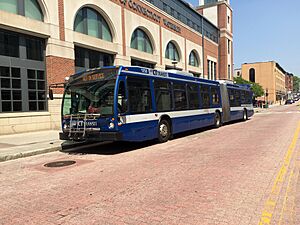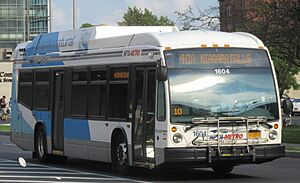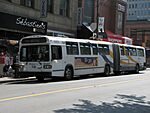Nova Bus facts for kids

Connecticut Transit Nova Bus LFS Articulated bus
|
|
|
Formerly
|
NovaBus Corporation |
|---|---|
| Subsidiary | |
| Industry | Automotive |
| Predecessor | General Motors Diesel Division Transportation Manufacturing Corporation |
| Founded | 1979 (plant) 1993 (company) |
| Headquarters | Saint-Eustache, Quebec, Canada |
|
Area served
|
Canada and United States |
|
Key people
|
Paul Le Houillier (President) |
| Products | Public transit buses |
| Owner | Volvo |
Nova Bus is a company from Canada that makes buses for public transportation. Its main office is in Saint-Eustache, Quebec. The company is part of the Volvo Group, which is a big company known for making vehicles.
Nova Bus started from a part of General Motors that opened in 1979. The company Nova Bus was officially created in 1993. This happened when a company called Nova Quintech bought the bus-making parts of Dial Corporation. Later, Volvo became a part-owner of Nova Bus in 1998. Volvo then took full ownership in 2004.
Contents
The Story of Nova Bus
Early Days and New Ownership
The factory in Saint-Eustache, where Nova Bus is located, used to be a General Motors plant. This plant started in 1979 and built buses for cities in Canada and the US. It made popular buses like the New Look bus and the Classic model.
In 1987, General Motors sold its bus-making business to Greyhound Dial Corporation. This company also owned Motor Coach Industries (MCI).
Nova Bus is Born
By the 1990s, Dial Corporation wanted to sell its transportation businesses. The factory in Saint-Eustache was at risk of closing. But then, a new company called Nova Bus Corporation was formed. It was created by people from Nova Quintech and a group that supports workers in Quebec. They bought the factory from MCI in 1993.
The government of Quebec helped by giving loans and promising to buy many buses. This helped Nova Bus get started. In 1994, Nova Bus also bought the rights to make the RTS bus model.
Focusing on New Designs
Nova Bus later stopped making the Nova Classic and Nova RTS buses. They wanted to focus on a new type of bus called the Nova LFS. This bus has a low floor, which means it's easier for people to get on and off. The first LFS buses were delivered in 1997.
In 2002, Nova Bus closed its factories in Roswell, New Mexico, and Niskayuna, New York. They decided to focus all their efforts on the Canadian market. However, they later returned to the US market.
Returning to the US Market
In 1998, the Chicago Transit Authority (CTA) was the first US customer to buy a large number of LFS buses. These buses were made and delivered between 2000 and 2002. The CTA is still one of the biggest users of Nova LFS buses.
In 2008, Nova Bus announced plans to build a new factory in Plattsburgh, New York. This showed their return to the US bus market. The factory opened in 2009. The New York City Transit Authority (NYCTA) was one of the first US customers for buses made there. They ordered many articulated (bendy) and regular LFS buses.
Other cities like Honolulu, Hawaii, and Philadelphia also ordered Nova Bus vehicles. In 2012, Walt Disney Company even tested a Nova articulated bus at Walt Disney World Resort. In 2013, the Chicago Transit Authority ordered 300 clean-diesel buses.
Recent Changes
On June 21, 2023, Nova Bus announced that it would leave the United States market again by 2025. They decided to close the Plattsburgh plant. This was because the company was losing money in the US. They chose to focus their business on Canada instead.
On March 28, 2024, Nova Bus announced that its president, Ralph Acs, would retire. Paul Le Houillier took over as president on June 1, 2024.
Nova Bus Products
Current Bus Models
The LFS (Low Floor Series) is the only bus model Nova Bus makes right now. It was the first bus designed by the company and started being made in 1996.
The LFS has been updated many times over the years. It first came as a 40-foot (12.19 m) bus that ran on diesel fuel. Now, there are many different versions.
Some LFS buses use different types of fuel, like compressed natural gas (CNG). Others are hybrid buses, which use both diesel and electricity. There are also fully electric versions. Since 2009, Nova Bus has also offered longer, articulated (bendy) versions that are 62 feet (18.9 m) long. They also make buses for suburban areas with fewer doors and more comfortable seats.
Past Bus Models
See also





